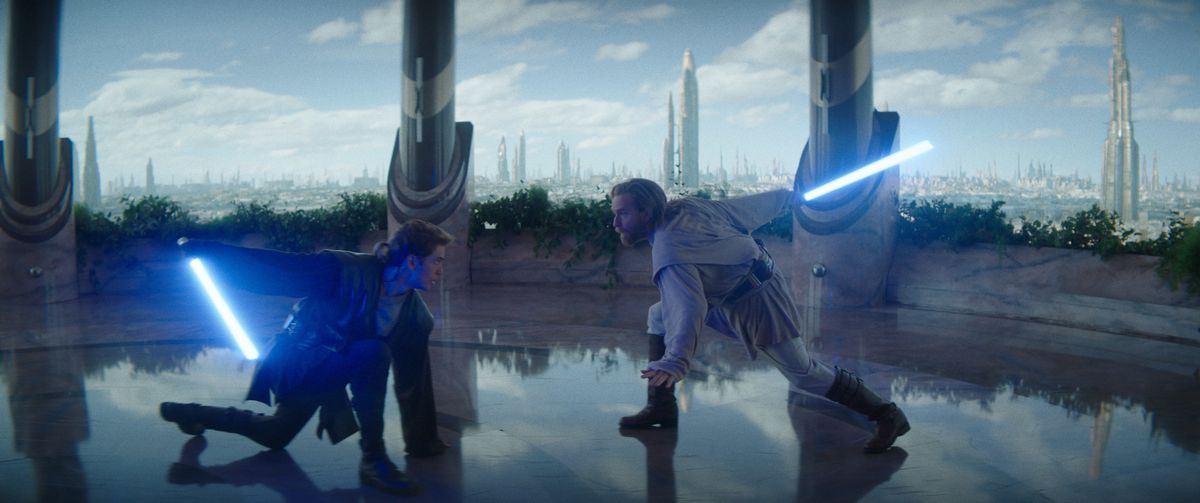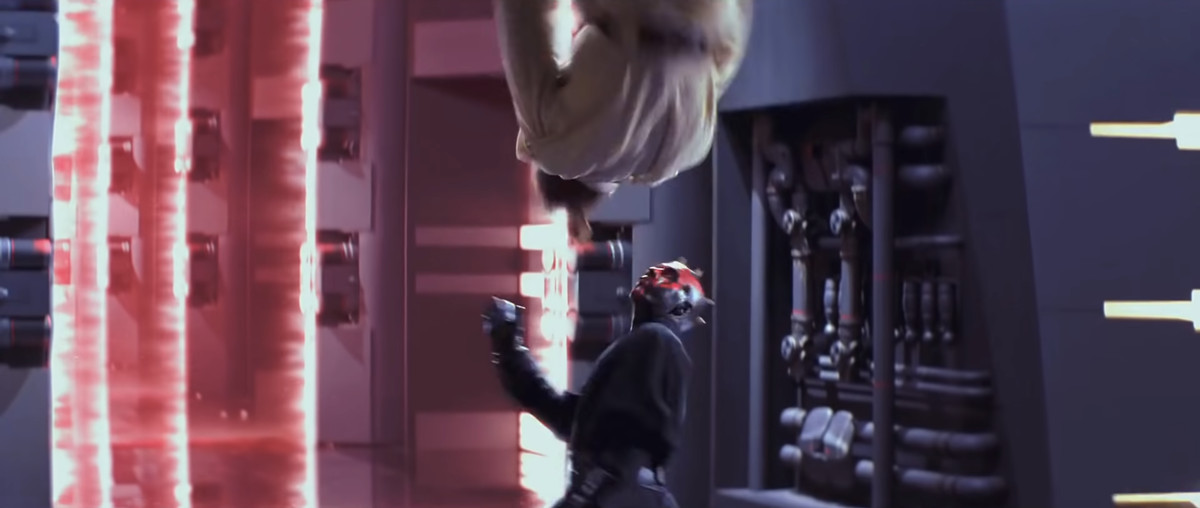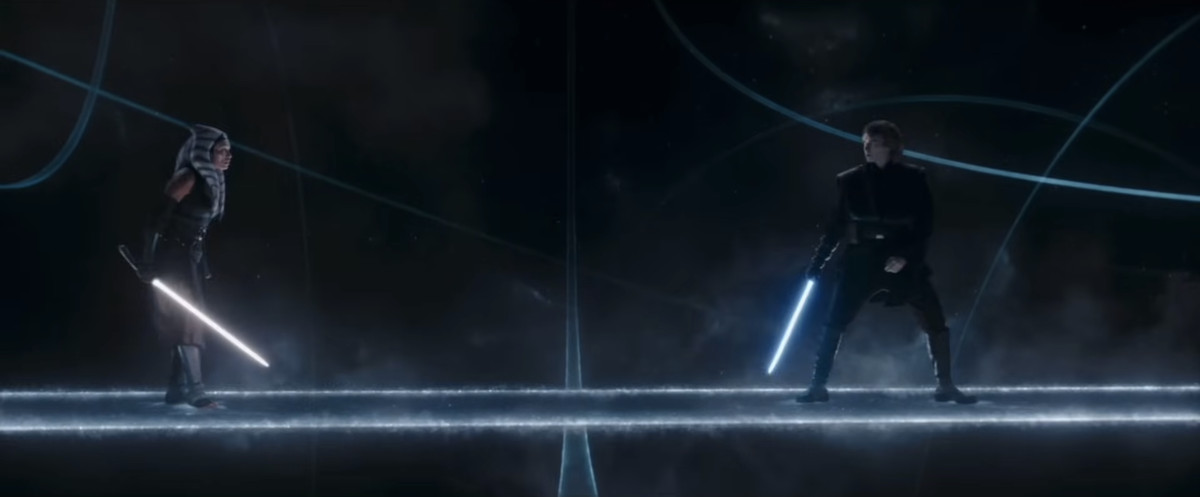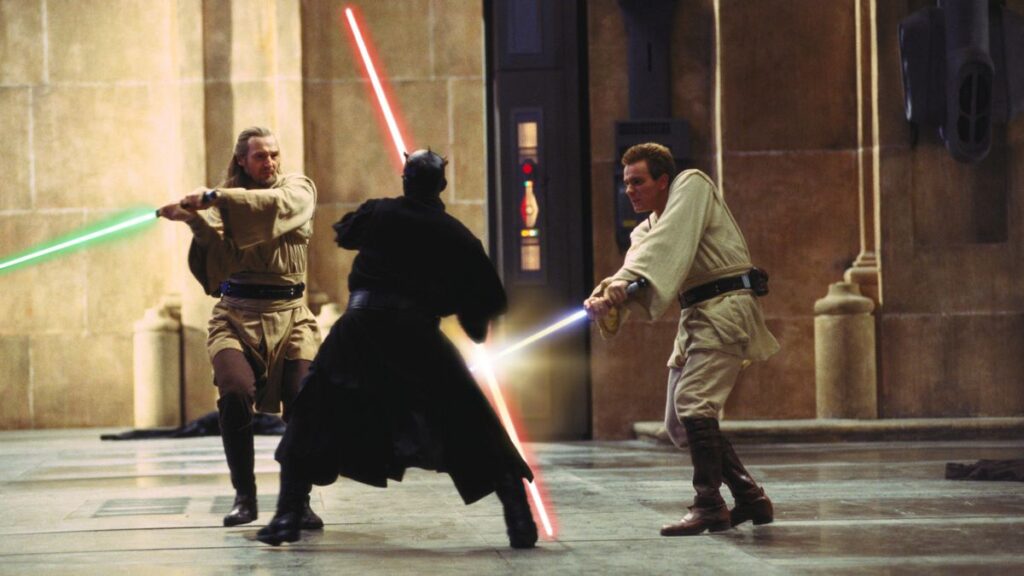Star Wars: Episode I – The Phantom Menace is returning to movie theaters on May 3 to celebrate its 25th anniversary. This essay was inspired by its re-release.
In the quarter century since the Star Wars prequel trilogy launched, The Phantom Menace and its siblings have been exalted, excoriated, relitigated, rehabilitated, beloved, and bemoaned. At the risk of cliche, they permanently changed what Star Wars meant to audiences and creators in terms of story, world-building, vibes, and visuals.
The Phantom Menace introduced a lot of new ideas to the franchise — a long, frequently embarrassing list that includes midi-chlorians, Jar-Jar Binks, and several uncomfortably accented alien species. But one of the best ideas it brought to Star Wars is on the verge of disappearing.
When did the Jedi lose their sick flips?
‘George has never been in a fight in his life’
Image: Lucasfilm
George Lucas is known for his affection for aerial dogfights in WWII cinema, not hand-to-hand fights. While the swordplay of the original Star Wars trilogy is iconic, there’s precious little finesse to it. The lightsaber duels are kinetic proxies for the emotional and philosophical clashes between characters, not set-pieces in and of themselves. The prequel trilogy’s move toward highly balletic, choreographed lightsaber battles wasn’t primarily Lucas’ doing; designing those fell squarely on the creative shoulders of stunt performer and coordinator Nick Gillard.
“George has never been in a fight in his life,” Gillard told Vulture in 2017. “So he didn’t bother, really, writing [a lightsaber duel]. It would say something like, ‘A vicious lightsaber battle ensues — seven minutes,’ and you could fill in the gap there.”
Gillard already had two decades of industry experience under his belt when he took on The Phantom Menace’s lightsaber combat. He’d worked with Lucasfilm productions off and on for nearly that long, starting with 1981’s Raiders of the Lost Ark. But the way he filled in “the gap” for the Jedi was entirely inspired by the movie action he was seeing on screen around him in the late ’90s. Given Lucas’ blessing and full creative freedom, Gillard crafted a bespoke Jedi martial art that was fast, mobile, and acrobatic, highlighting the order’s supernatural reflexes and Force-aided aerial abilities.
The fight scenes that ensued — most notably the climactic duels of The Phantom Menace and Revenge of the Sith — were among the only aspects of the prequel trilogy that escaped derision. It wasn’t just the choreography, either. These duels were extraordinarily ambulatory and interactive, moving through rooms and changing environments. They showed sabers casually slicing through walls and stabbing through electronics panels, leaving sparks flying and fuel hoses whipping about. They favored swings that cut diagonally across the camera’s gaze, the better to turn sabers into smears of light instead of simple lines. The prequels shifted Star Wars’ location on the subgenre map to the border of martial arts action, in an era when wire-fu standards like The Matrix, Crouching Tiger, Hidden Dragon, Kill Bill, and, dare I say, Charlie’s Angels were firmly grabbing multiplex-goers’ eyeballs.
But Gillard’s influence has faded as Star Wars has moved back to live action, and as the franchise has moved away from presenting the Jedi in their prime. The saber duels of Star Wars’ modern crop of TV shows can’t hold a candle to the ones we see in the prequel trilogy.
An elegant flip for a more civilized age

From The Force Awakens forward, live-action Star Wars has largely turned the camera away from temple-trained, prime-of-life Jedi knights. Rey is a self-taught quarterstaff fighter, and Kylo Ren killed all of his classmates. The Mandalorian, The Book of Boba Fett, and Andor either feature no Jedi or carefully keep them in the background, making much of the singular status of Din Djarin’s Darksaber — so saber-on-saber clashes are few and far between.
Even as Jedi have come back into focus in the Disney Plus shows, with precious few exceptions the sword duels have been slow, stagey, and even… perfunctory. I worried I’d exaggerated the difference in my mind until I started pulling up videos of the prequels while writing this article. Watching those fights and the most recent ones side by side, the difference in speed is immediately noticeable.
Certainly it makes sense that the badassery of a lightsaber fight should be lessened somewhat if the practitioners weren’t handed a saber at the same time they were learning to tie their own shoes. But even in scenes with canonically proficient Jedi knights giving it their all — Ahsoka’s duel with Baylan Skoll, Obi-Wan and Anakin’s flashback sparring — it’s a watered-down shadow of how things once were.
Maybe I’m being harsh. Gillard set a high standard that is difficult to reach. And perhaps you like the modern saber duels just fine — it’s a subjective valuation, after all. But I have one more question, based on 100% objective criteria: Where are the fucking jumps?
Why do all Jedi have their feet glued to the floor now?

Image: Lucasfilm
The Jedi “Force leap” — I’ll be continuing to refer to it as “sick flips,” thank you — is not a Gillard invention. It goes all the way back to the original Lucas trilogy, where we see Luke training on midair somersaults with Yoda. He later employs that Force-powered jumping prowess to leap out of the carbonite chamber in The Empire Strikes Back, and to escape the Sarlacc pit in Return of the Jedi.
But Star Wars’ prequel trilogy elevated that power to an art form. Sick flips were no longer just used to get out of a bind — Gillard wove them through the Jedi martial art like breathing. The very first thing that happens in Obi-Wan and Qui-Gon’s legendary Phantom Menace fight with Darth Maul is that Obi-Wan does a sick flip over Maul so the Sith lord is flanked. And the very last thing, as Obi-Wan avenges his fallen master? That’s right, he does a sick flip out of a pit, sails over Maul’s head, and bisects him.
How does Attack of the Clones confer Yoda’s mastery of the philosophy of the Force in his saber style? Why, by giving him exponentially more sick flips than any other Jedi! Anakin and Obi-Wan’s pivotal battle on Mustafar in Revenge of the Sith begins with a sick flip, as Anakin launches himself across a platform at his master. It ends with one as well, as Obi-wan relieves Anakin of all three of his remaining natural limbs. That’s what the entire infamous “I have the high ground” conversation is about! Obi-wan is saying, “Don’t do a sick flip from down there! It won’t work on me, because I invented that.”
The sick flip remains the clearest trademark of the Jedi martial art — any franchise could introduce fast, lethal, and mobile swordplay. But the Force-assisted flip is bespoke to Star Wars. The Clone Wars and Rebels shows, with their animated environs, kept the flip ubiquitous in the fallow live-action Star Wars era between the prequels and The Force Awakens. And yet the flip is nowhere to be seen in the live-action shows, even in duels between Obi-Wan and Anakin, Anakin and Ahsoka, and Ahsoka and Baylan Skoll.
I don’t want to imply that planning and staging great martial arts scenes is easy, much less staging fights that rely on your lead performers rather than seasoned stuntpersons. Quite the opposite! They require a ton of pre-production work, and demand a lot from actors. That’s likely a not-insignificant source of the difference between the choreography of the prequel trilogy and the various Disney Plus series. The scheduling demands of episodic television are fundamentally different than those of a film production, and we live in an era defined by a Hollywood push to make more stuff faster, rather than taking time to make things well.

Image: Lucasfilm
But I miss the inventiveness and mobility of the prequels’ fights. Watching Ahsoka, I was struck by how strikingly Hayden Christensen’s movements differ from his co-stars’. He drops his center of gravity, slides through his footing with predatory grace, and employs a good old dazzlingly fast saber spin when he gets the chance. It’s clear that the fundamentals of theatrical swordplay Gillard drilled into him during production on Attack of the Clones and Revenge of the Sith are still there.
Maybe Star Wars will never again hit the sweet-spot combination of resources, talent, and contemporary action tastes that will allow it to border on wire-fu and martial arts cinema. Maybe I will never realize my dream of once again watching Jedi soar through the air to dunk on their opponents. Then again… there’s The Acolyte.
The upcoming Disney Plus series has the overt mandate of showcasing a time when the ancient past of the Jedi Order, when it was was truly at its peak and not about to take a fall. Trailers for the show have been heavy on martial arts, with even a peek at some wire-fu. And most intriguingly, the biggest name on the cast is The Matrix’s own veteran Carrie-Anne Moss, who is absolutely no stranger to sick flips. This is Star Wars: We can always hope.

